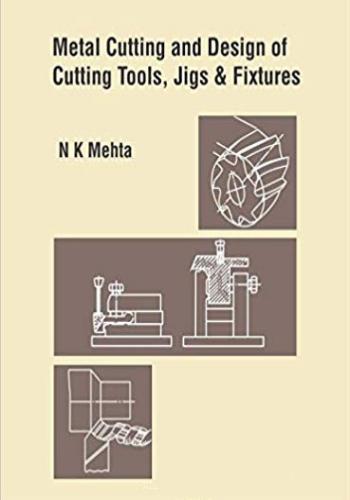Admin
مدير المنتدى


عدد المساهمات : 18996
التقييم : 35494
تاريخ التسجيل : 01/07/2009
الدولة : مصر
العمل : مدير منتدى هندسة الإنتاج والتصميم الميكانيكى
 |  موضوع: كتاب Metal Cutting and Design of Cutting Tools, Jigs & Fixtures موضوع: كتاب Metal Cutting and Design of Cutting Tools, Jigs & Fixtures  الخميس 04 يوليو 2019, 2:57 pm الخميس 04 يوليو 2019, 2:57 pm | |
| 
أخوانى فى الله
أحضرت لكم كتاب
Metal Cutting and Design of Cutting Tools, Jigs & Fixtures
N. K. Mehta

و المحتوى كما يلي :
Contents
Preface
1.1 miroduction
1.1.1 Basics of Meta[ Cutting
1.1.2 Working and Auxiliary Motions in Machine Tools
1.2 Concept of Speed, Feed, Depth of Cut, and
Machining Time
Lathe Operations
Drilling and Allied Operations
Milling Operations
1.5.1 Indexing Based on Periodic Rotation
1.5.2 Indexing Based on Continuous Rotation
1.6 Shaping and Allied Operations
T.7 Grinding Operations
1.7.1 External Cylindrical Grinding
1.7.2 Internal Cylindrical Grinding
1.7.3 Surface Grinding
1.8 Geometry of Single-Point Tool
— 1.8.1 Orthogonal System
Review Questions
2. Geometry of Chip Formation
2.1 Process of Chip FormationParameters of Undeformed Chip in Turning
Drilling, and Milling
2.2.1 Undeformed Chip in Turning
2.2.2 Undeformed Chip in Drilling
2.2.3 Undeformed Chip in Plain Milling
2.2.4 Undeformed Chip in Face Milling
Shear Angle and Shear Strain in Chip Formation
2.3.1 Shear Angle
2.3.2 Shear Strain
Types of Chips
2.4.1 Discontinuous Chips
2.4.2 Continuous Chips
2.4.3 Partially Continuous Chips
2.4.4 Element Chips
Chip Flow Control and Chip Breaking
2.5.1 Control of Chip Flow
2.5.2 Chip Breaking
Review Questions
Mechanics of Machining Process
Orthogonal and Oblique Machining
Force Velocity and Energy Relations in
Orthogonal Machining
3.2.1 Force Relations
3.2.2 Velocity Relations
3.2.3 Energy Relations
Theoretical Determination of Cutting Force
3.3.1 Determination of Dynamic Shear Stress
3.3.2 Shear Angle Relations
3.3.3 Forces in Drilling
3.3.4 Forces in Milling
Built-Up Edge
3.4.1 Characteristic Features of BUE
Effect of Tool Geometry and Machining
3.5Parameters on Cutting Force
Review Questions
4. Tool Wear and Thermodynamics of Chip Formation
4.1 Heat Sources and its Distribution
4.2 Tool Failure and Tool Wear
4.3 Growth of Tool Wear with Cutting Time, Wear
Criteria
, and Wear Mechanisms
4.3.7 Tool Wear Criteria
4.3.2 Tool Wear Mechanisms
4.4 Tool Life and Machinability
4.5 Tool Life Testing
4.5.1 Facing Test
4.5.2 Variable Speed Test
4.6 Effect of Various Factors on Tool Life
4.6.1 Effect of Work Material
4.6.2 Effect of Tool Material
4.6.3 Effect of Tool Geometry
4.7 Machinability
4.7.1 Surface Finish
4.1.2 Machinability Index
4.8 Theoretical Determination of Cutting Temperature
4.8.1 Temperature Relations for Various Heat
Sources
4.8.2 Shear Plane Temperature
4.8.3 Tool-chip Interface Temperature and
Cutting Temperature
4.9 Economics of Machining
4.9.7 Sequence of Assigning the Machining
Parameters
4.9.2 Selection of Depth of Cut
4.9.3 Selection of Feed
4.9.4 Selection of Optimum Cutting Speed
Review Questions5. Geometry of Cutting Tools
5.1 Issues in Geometry of Single-Point Tools
5.1.1 Effect of TooI Setting and Feed on Rake
and Clearance Angles
5.1.2 Selection of Optimum Tool Angles
Geometry of Form Tool
Geometry of Drill
Geometry of Milling Cutters
5.4.1 Geometry of Plain Milling Cutter
5.4.2 Geometry of Face Milling Cutter
Geometry of Broach
Geometry of Thread Cutting Tools
5.6.1 Geometry of Single-Point Thread Cutting Tool
5.6.2 Geometry of Thread Chasers
5.6.3 Geometry of Thread Cutting Taps
5.6.4 Geometry of Thread-Cutting Die
Geometry of Gear Cutting Tools
Review Questions
6. Design of Cutting Tools
Design of Single-Point Tool
6.1.1 Features Related to Cutting Bit
Design of Form Tool
6.2.1 Design of Circular Form TooI
6.2.2 Design of Flat Form Tool
Design of Drills
Design of Milling Cutters
6.4.1 Design of Plain Milling Cutter
6.4.2 Design of Face Milling Cutters
Design of Broach
Design of Thread Cutting Tools
6.6.1 Design of Taps
6.6.2 Design of Thread Cutting Dies
6.66.7 Geometry and Design of Gear Cutting Tools
6.7.1 Geometry and Design of Module Cutter
6.7.2 Geometry and Design of Gear Shaping
Cutter
6.1.3 Geometry and Design of Hob
Review Questions
7. Design of Jigs and Fixtures
7.1 introduction
Location Principles, Methods, and Elements
7.2.1 Concept of Design, Setting, and Measuring
Datum Surfaces
7.2.2 Locating Scheme, Error Analysis, and
Elements for Prismatic Parts
7.2.3 Locating Scheme, Error Analysis, and
Elements for Long Cylindrical Parts
7.2.4 Locating Scheme, Error Analysis, and
Elements for Short Cylindricai Parts
7.2.5 Locating Scheme, Error Analysis, and
Elements for Parts with Through Hole
7.2.6 Locating Scheme, Error Analysis, and
Elements for Parts with Flat Base and Two
Predrilled Holes
7.2.7 Locating Scheme, Error Analysis, and
Elements for Parts with Center Holes at
End Faces
Clamping Principles, Methods, and Elements
7.3.1 Clamping Principles
7.3.2 Clamping Force Calculation
7.3.3 Clamping Mechanisms and Applied Force
Calculation
7.3.4 Clamping Elements and Devices
Tool Guiding Elements
Indexing Devices
Body of Jigs and Fixtures
7.67.7 Power Devices
Review Questions
8. Classification of Jigs and Fixtures and Their
Economic Analysis
8.1 Classification of Jigs and Fixtures
8.1.1 Universal General-Purpose Fixture ( UGP )
8.1.2 Universal Adjustable Fixture ( UAF )
8.1.3 Special Adjustable Fixture ( SAF )
8.1.4 Reassemblable Fixture ( RAF )
8.1.5 Universal Built-Up Fixture ( UBF )
8.1.6 Special Fixtures ( SPF )
Economics of Jigs and Fixtures
8.2.1 Calculation of Annual Cost of Fixture
8.2.2 Relative Economic Analysis
Review Questions
8.2
Bibliography
Index
كلمة سر فك الضغط : books-world.net
The Unzip Password : books-world.net
أتمنى أن تستفيدوا من محتوى الموضوع وأن ينال إعجابكم
رابط من موقع عالم الكتب لتنزيل كتاب Metal Cutting and Design of Cutting Tools, Jigs & Fixtures
رابط مباشر لتنزيل كتاب Metal Cutting and Design of Cutting Tools, Jigs & Fixtures 
|
|







